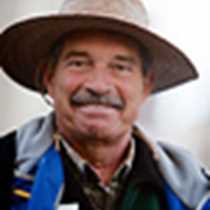Pavlov Harbor, Chichagof Island, Southeast Alaska
The Russians were here for 126 years, during which time they extensively hunted sea otters and other fur bearers. Many of the features of today’s Alaska have Russian names, and in this case the island where we hiked and saw salmon today is called Chichagof, the bay, Pavlof. Geologically it is almost completely made up of Devonian volcanic rocks, of a lovely light-brick hue, and the river that leads to Pavlof Lake is a waterway to the lake for the innumerable salmon that will eventually spawn there.
We had the opportunity of walking to the small dam where a salmon catching cage is situated, and see one of the Alaska natives of the FWS measure a couple of animals, mark them and remove three scales for further study in the lab. The fishes were then released in the lake. These studies serve to have an idea of the local population size, and will eventually lead to the allowed catch of these animals for next year.
We hiked up to this dam, and others made a longer foray into the lake shores and surrounding areas. A brown or grizzly bear had been there earlier and stolen the fish that four fishermen had caught, making then quite unhappy!
Another sport today was the kayaking. In these single and double kayaks we paddled around the bay, getting a good look at the river and dam, the salmon in the ocean from above, and the lovely forest’s nooks and crannies. Together with a sunny day, this was marvelous!
The Russians were here for 126 years, during which time they extensively hunted sea otters and other fur bearers. Many of the features of today’s Alaska have Russian names, and in this case the island where we hiked and saw salmon today is called Chichagof, the bay, Pavlof. Geologically it is almost completely made up of Devonian volcanic rocks, of a lovely light-brick hue, and the river that leads to Pavlof Lake is a waterway to the lake for the innumerable salmon that will eventually spawn there.
We had the opportunity of walking to the small dam where a salmon catching cage is situated, and see one of the Alaska natives of the FWS measure a couple of animals, mark them and remove three scales for further study in the lab. The fishes were then released in the lake. These studies serve to have an idea of the local population size, and will eventually lead to the allowed catch of these animals for next year.
We hiked up to this dam, and others made a longer foray into the lake shores and surrounding areas. A brown or grizzly bear had been there earlier and stolen the fish that four fishermen had caught, making then quite unhappy!
Another sport today was the kayaking. In these single and double kayaks we paddled around the bay, getting a good look at the river and dam, the salmon in the ocean from above, and the lovely forest’s nooks and crannies. Together with a sunny day, this was marvelous!




